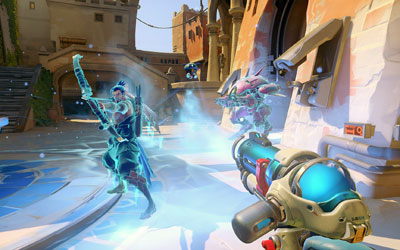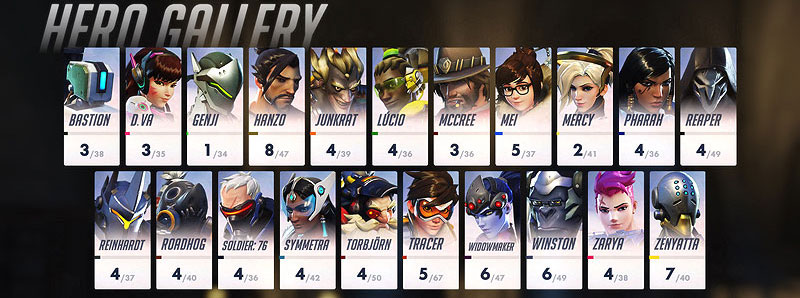Overwatch for Beginners, Part I: Introduction
 Blizzard's latest game, Overwatch, has its global release on Monday night, May 23 on PC, PS4, and XBone. I normally don't jump on the hype bandwagon for new games (the last game I preordered may have been the highly disappointing Ultima IX in 1999), but the hundred hours I spent playing the beta has convinced me that this is going to be a huge hit. Besides the obvious care, charm, and polish baked into the package, the game features the same addictiveness and accessibility that made World of Warcraft intriguing to gamers who wouldn't normally be interested in the genre.
Blizzard's latest game, Overwatch, has its global release on Monday night, May 23 on PC, PS4, and XBone. I normally don't jump on the hype bandwagon for new games (the last game I preordered may have been the highly disappointing Ultima IX in 1999), but the hundred hours I spent playing the beta has convinced me that this is going to be a huge hit. Besides the obvious care, charm, and polish baked into the package, the game features the same addictiveness and accessibility that made World of Warcraft intriguing to gamers who wouldn't normally be interested in the genre.
Overwatch aims to do the same for first-person team shooters, where you compete in teams of 6 to accomplish different objectives. While kills and reflexes are important, coordinated teamwork is a must, and there are roles that even people with the aiming skills of North Korea can perform to help their team succeed. The heroes fall into the traditional MMO categories (tanks, damage dealers, and healers) and all 21 are varied enough to lead to unexpectedly satisfying team compositions.
 You might enjoy the animated shorts that Blizzard has released to develop the lore behind the game (although the story is more for flavor than an essential part of the game). Even if you're not a gamer, you'll appreciate their high quality production:
You might enjoy the animated shorts that Blizzard has released to develop the lore behind the game (although the story is more for flavor than an essential part of the game). Even if you're not a gamer, you'll appreciate their high quality production:
Matches take place on well-designed maps in scenic global locales and consist of three game modes: Defenders try to prevent Attackers from capturing a control zone, both teams try to claim the same control zone (King of the Hill), or Defenders try prevent Attackers from escorting a payload to a final destination. Some maps feature a mix of these objectives. Objectives take precedence over deathmatch kills, and it doesn't matter if you've killed 20 enemies if you end up losing control of a capture zone.
Besides running, jumping, and crouching in a 3D world, each hero has a very constrained skillset, generally consisting of a primary shooting ability, a secondary shooting mode, two support skills, and an "ultimate" ability that can only be used after you've charged it up over time (not unlike heroes in Warcraft 3). This makes it easier to try out and enjoy different heroes without having to master tons of key bindings. The tutorial hero, Soldier: 76, is the most traditional hero, and a good starting point if you ever played DOOM or Team Fortress as a wee youth with a 9600 baud modem.

The game comes with a basic tutorial and then drops you straight into the action. You can opt to play against the computer to get comfortable, but this gets boring pretty quickly. I was surprised by how much more interesting the game got simply by adding unpredictable real players to the mix. Games against real people are overwhelmingly chaotic when you first start -- you will die a million times and have no idea what all of the heroes are doing to you, but you'll enjoy every second of it. The art style, sound design, and animations all blend into a giant interactive Looney Tunes cartoon.
If you're interested in playing Overwatch, you should take a look at Overwatch: A Complete Beginner's Guide. Here are a few quick tips for your first games:
- After you die, you come back to life in a "spawn room" and have to run back to the battlefront. Try to travel by different routes to get back to the action and you'll learn the maps that much more quickly. You may even discover useful shortcuts -- with the exception of a few chokepoints, there are always multiple ways to get around. You can also load up a map in a Custom Game and explore it at your leisure.
- You can change your hero on the fly after dying, but this erases any ultimate charge you've built up. Try to use your ultimate ability before switching so it doesn't go to waste.
- Tapping TAB during the game will give you a quick idea of who's alive on your team. If the whole team just died, you may want to regroup instead of wandering back to the battle one at a time. You can also enable a Kill Feed in the Options menu.
- Proximity is a very important (and under-explained) concept in all game modes. You need to be within the colorful boundary of a control zone for a certain amount of time to capture it. As a Defender, you can contest the capture by standing in the zone yourself. Likewise, Attackers can make the payload travel faster when more people are nearby (and being close to the payload will heal you). Defenders can contest the forward motion of the payload by standing close by.
Next Tuesday in Part II, I'll give a brief overview of the 21 heroes and provide some suggestions on the easiest heroes to get started with!

|
tagged as
games
|
permalink
| 3 comments
|
|
|
Previous Post: Review Day |
Next Post: Weekend Wrap-up |
You are currently viewing a single post from the annals of URI! Zone history. The entire URI! Zone is © 1996 - 2024 by Brian Uri!. Please see the About page for further information.
